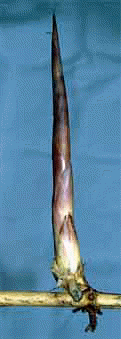 Bamboo Morphology Bamboos are part of the grass family, but unlike the other
subfamilies, the 1,050 to 1,070 species of the Bambusoideae produce woody
stems, which include deposits of silica. The silica makes bamboo culms one of
the toughest of organic structures. Bamboo Morphology Bamboos are part of the grass family, but unlike the other
subfamilies, the 1,050 to 1,070 species of the Bambusoideae produce woody
stems, which include deposits of silica. The silica makes bamboo culms one of
the toughest of organic structures.
The growth habit of bamboo species depends upon their
underground rhizomes. Clump forming or pachymorphic species have short, thick
rhizomes which produce shoots only at their tips, which results in a tight stand
of culms that expands fairly evenly around its circumference. Running or
leptomorphic species have long, thin rhizomes extending over great distances
which produce shoots along their whole lengths - the most invasive species
belong to this group. A third group, the intermediates, have root systems
showing aspects of both types. Leptomorphic species grown in cooler conditions
than they are used to often have a more clumping habit.
Most bamboos flower very rarely - perhaps only once every 70 or
80 years - meaning they are not often grown from seed but are generally
propagated by division, which can make them expensive.
Back
More |